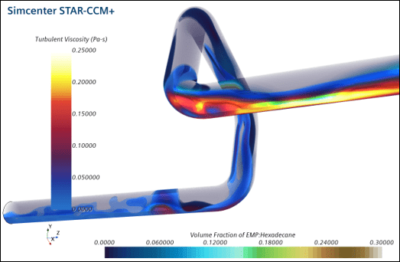In this blog post we will keep looking at some important highlights of the new features for Simcenter STAR-CCM+ version 2021.3. This version of the software was released last week and contains several improvements worth highlighting. Last week’s post focused on the following features; user experience, 3D-CAD, mesh pipeline, fluid flow and turbulence, and can be found here [Simcenter STAR-CCM+ 2021.3 news – part 1 – VOLUPE Software]. This week will mainly focus on updates regarding multiphase simulation applications.
S-Gamma for DMP
In the release, 2021.2, Population balance modelling was made available for Mixture multiphase (MMP). In this release the Dispersed multiphase model (DMP) sees the same inclusion. DMP is a lightweight Eulerian model that in reality is an additional model to a continuous flow simulation, meaning that you can use it with low volume fractions (<1%) and still maintain physical relevance. Before, the DMP model was limited in application since all droplets in a dispersed phase was of the same diameter. Now the S-gamma for DMP includes physics such as breakup and coalescence.
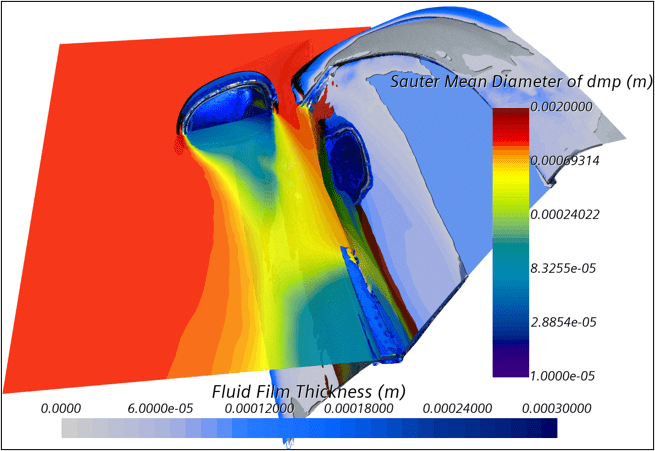
VOF to Lagrangian transition manager
Volume of fluid to Lagrangian multiphase, basically VOF to particles, is getting more updates. Since its introduction where the only blob diameter was a transition criterion, now aside from that, the blob shape and any arbitrary user criteria can be used to decide when the VOF phase turns in to particles. The update concerns the usage and specification of the transition criteria. The user criteria’s can be e.g., zonal criteria’s, you can also have multiple criteria in the user defined section.
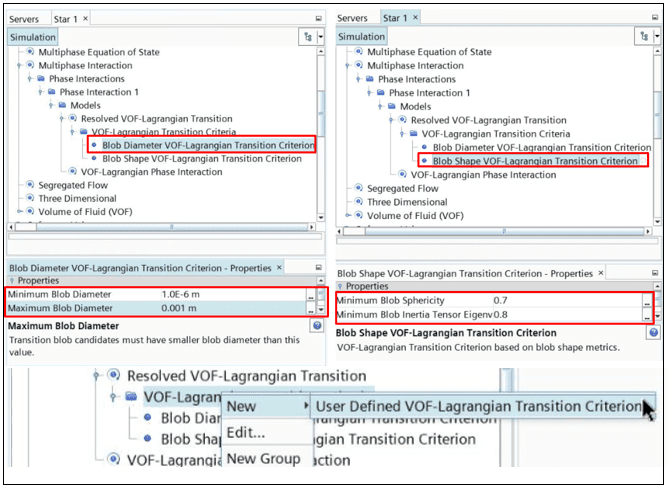
EMP – adaptive time-step providers and source smoothing with fluid film
There are also a couple of updates for the Eulerian Multiphase (EMP). The first one being two new time-step providers.
- Smoothed Convective CFL – sets the timestep based on the CFL number through the domain, something that was previously available outside of EMP.
- LSI Smoothed Convective CFL – a version of the above for use with LSI simulations. Then only considers the CFL in the vicinity of large-scale interfaces/free surfaces.
The use of the adaptive timestep allows for a larger mean timestep in your simulation, and an automatic reduction when the physics require.
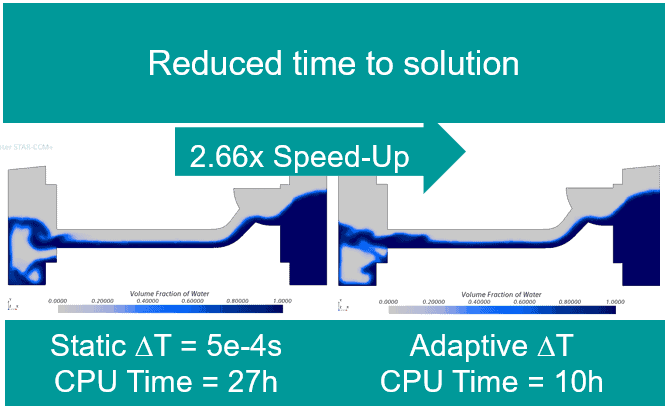
The second update in reference to the EMP solver is source smoothing for fluid film stripping into Eulerian multiphase. Fluid Film stripping removes mass from the film on surfaces and adds it to the Eulerian phase in the adjacent cell. When a low y+ mesh is used sometimes this can cause instabilities by overwhelming the near wall cell with too much mass. An option to use source smoothing has been added in this release to spread the stripped mass over several cells. This improves stability and enables cases to be run faster, and in most cases, this has little effect on accuracy (as it is equivalent to a mesh coarsening locally for stripping).
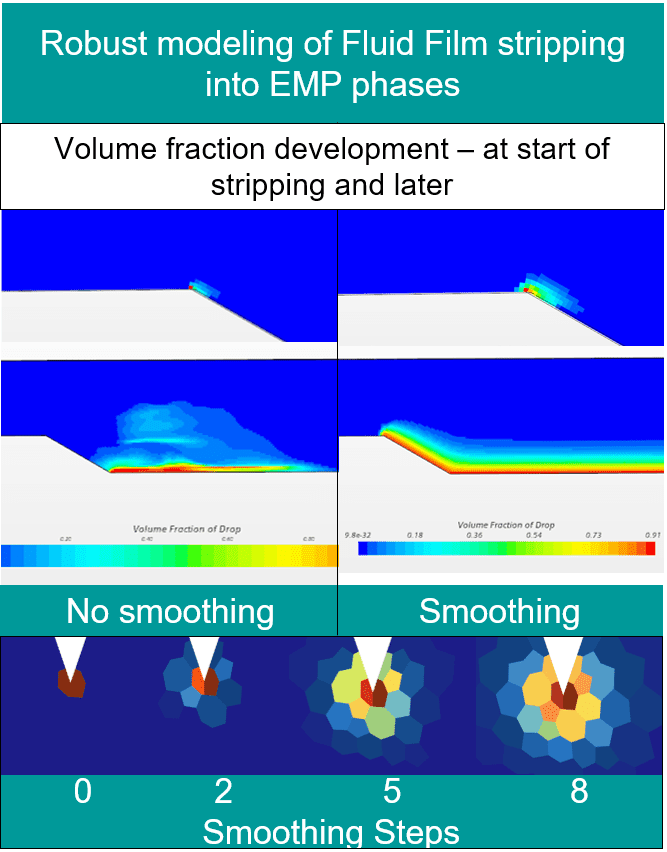
Turbulence for fluid film
And speaking of fluid film, one big update is that is now possible to run turbulence for your fluid film. This improves the accuracy with fluid film for many industrial problems. Previously the fluid film could only be laminar, now you can select between the Cioncolini model (suited for annular flows), the Mudawwar model (suited to heated films) or your own model (a field function). This addition is particularly relevant for thick films. It gives consistency with VOF and hybrid VOF-Film since the VOF phase can be either laminar or turbulent.
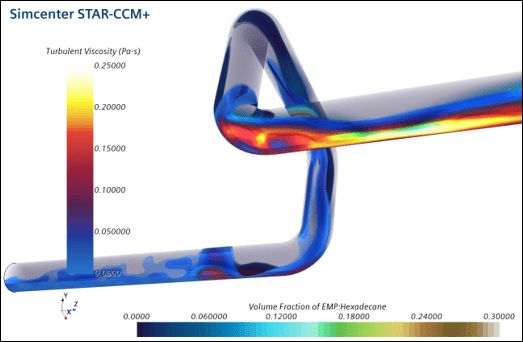
DEM – now made meshfree, model for flexible fibers
The Discrete element method (DEM) has its largest update since sliced bread! It is now possible to run meshfree. You no longer need a background mesh for DEM-simulation. Running meshfree is best suited for applications in Heavy equipment industry like soil/rock excavation, agricultural equipment design and mining/construction equipment. The fact that no mesh is needed, removes several steps for the workflow; it no longer requires a volume meshing step, selection of models for the continuous phase or overset mesh for motion.
In the example below and excavator bucket has been simulated containing 65000 parcels with parcel size of 16 mm and the case has been run on 16 cores. The graph to the right shows the solver elapsed time per timestep. This example shows a 4x speedup for the meshfree model.
The DEM approach has been given a new shape model as well. The flexible fibers model allows for simulation of non-spherical fiber segments. Instead, each fiber is made from many cylindrical segments, which allows modeling a long and thin fiber with small number of DEM elements. The joints between cylindrical segments uses a reduced order bonding model for transmitting the forces and torques, providing stable solution for larger values of DEM timestep. With this new model, all applications using flexible elongated particles will enjoy an improved ease of use and computational speedup. The previous solution, using clumped particles, is orders of magnitude slower. The vacuum cleaner simulation below shows how fibers are collected from a flat surface.
Honourable mentions
Nucleate boiling for MMP – The nucleate boiling model previously available for the Eulerian Multiphase Model (EMP) has been made available for Mixture Multiphase (MMP). This puts more accurate boiling modeling into the hands of a wider range of users. Unlike the simpler correlation-based models such as Rohsenow, this model includes many more physical models and can predict boiling behavior over a wide range of applications and regimes.
Phase mass conservation Error Report – For multiphase simulations the mass balance of each phase is an important metric to monitor convergence. A new report has been added, the “Mass Conservation Error” which is available for phases of any of the Eulerian family of models (VOF, MMP, EMP, Fluid Film and DMP). One can now use a cumulative monitor to track that error over time. Which is particularly useful for transient problems in closed systems to identify systematic mass errors before they can accumulate.
As usual we at Volupe hope that this has been useful for you, and that it will help you with your simulations in Simcenter STAR-CCM+. Do not hesitate to reach out to support@volupe.com if you have any questions.
Author
Robin Victor
support@volupe.com
+46731473121

